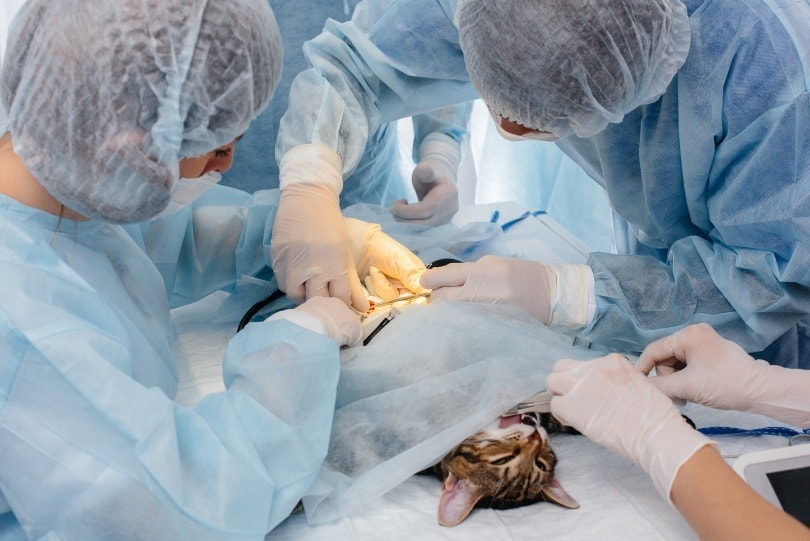Dog Paw Problems: 9 Common Issues & Solutions (Vet Answer)
By Dr. Sharon Butzke, DVM (Vet)
Updated on
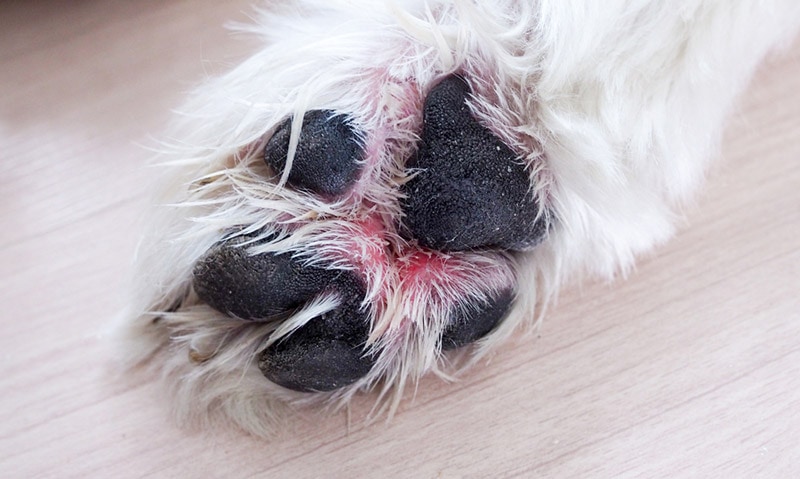
It is important to keep your pup’s paws in tip-top shape so they can walk, run, and play! Before getting into common paw problems, here are some facts about dogs’ feet:
- Dogs walk on their toes (digitigrade),1 like cats, rather than the soles of their feet (plantigrade), like people.
- Most dogs have four weight-bearing digits on their front and hind feet, plus a dewclaw on the inside of each front paw (like a thumb).
- Some dogs have dewclaws on their hind feet as well; this is most commonly seen in livestock guardian breeds like the Great Pyrenees.
- Dogs’ paw pads provide grip and absorb the shock of movement.
In this article, we will review some common paw issues that can affect our canine friends and what can be done to help. We will also offer some tips for keeping your dog’s paws happy and healthy!
The 9 Dog Paw Problems
1. Excessively long or ingrown nails
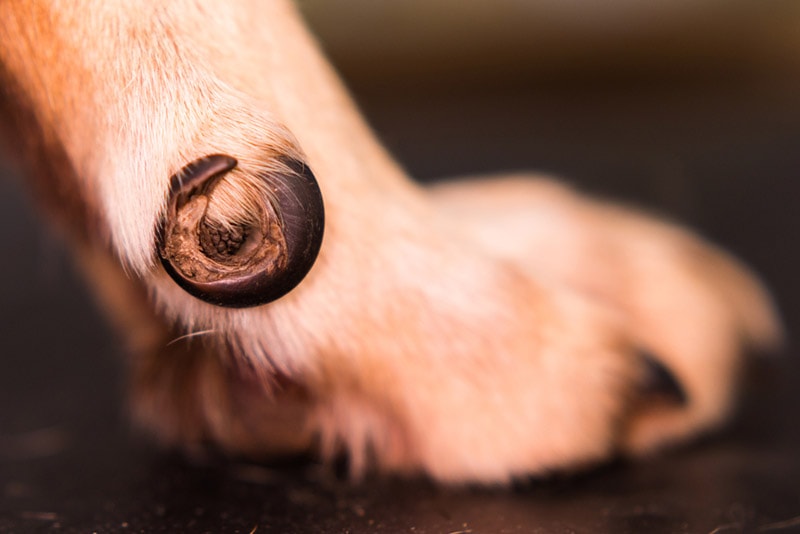
While dogs’ nails naturally get some wear through their normal activities, it is important to check them regularly and trim them when needed. Long nails can cause your pup discomfort and they are also at risk of getting caught on things, which can lead to injury.
Some breeds (e.g., Pugs and Dachshunds) have quite curved nails, which can grow into the foot pads if they become too long. In most other breeds, this problem tends to be limited to dewclaws. Ingrown nails hurt and often become infected.
For these particular issues, prevention is key. With practice and positive reinforcement,2 many dogs learn to accept having their paws handled and their nails trimmed regularly. If you do not feel comfortable trimming your pup’s nails at home, book an appointment with your veterinary clinic or a local groomer instead.
If you notice a nail growing into your dog’s foot pad, they need to be seen by a veterinarian right away. For dogs who are extra sensitive about their paws being handled, sedative medication may be given to help them relax. The affected nail will be trimmed, the ingrown part removed, and the area cleaned with an antiseptic solution. A bandage may be applied to protect the sensitive pad and keep it clean while it heals. Your dog will likely go home with some pain medication and antibiotics.
2. Broken nails
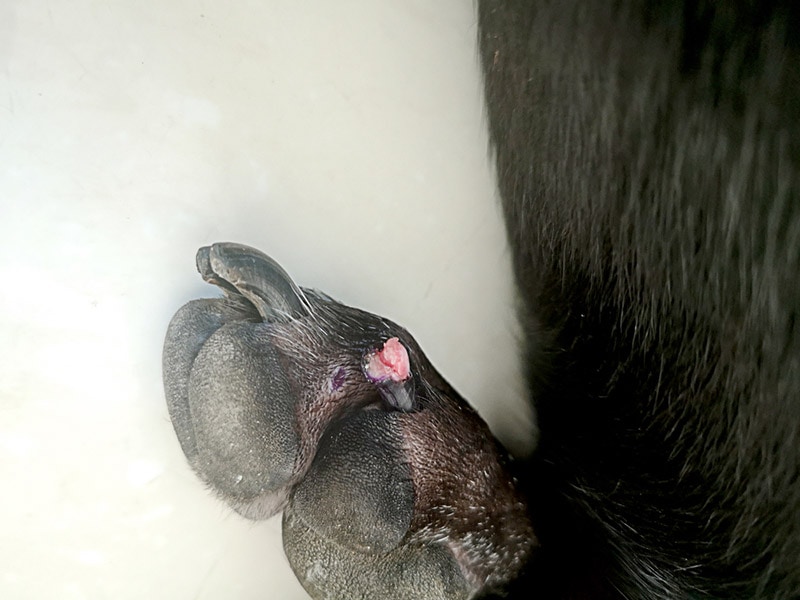
As previously mentioned, long nails (especially dewclaws) are at risk of getting caught and torn/broken. Keeping your dog’s nails trimmed nice and short is the best thing you can do to prevent broken nails.
If your pup seems to have particularly brittle nails that are prone to breaking or splitting even when they are short, ask your veterinarian if there could be an underlying medical condition that needs to be addressed (e.g., lupoid onychodystrophy).3
If your dog breaks a nail and the living part (known as the “quick”) is exposed, expect some bleeding. While this can be alarming, rest assured that it usually looks worse than it is. Many veterinarians recommend keeping a clotting product (e.g., styptic powder) on hand, which is also useful if you happen to trim one of your dog’s nails too short by accident. If you do not have styptic powder, cornstarch can also work.
- Put a small amount of the clotting agent directly on the spot that is bleeding and apply gentle pressure for a minute or two.
- Once the bleeding is under control, inspect the nail to see if there is a fragment that needs to be removed.
- If the broken piece of nail is still attached, it is a good idea to seek help from a veterinarian (especially if your dog is sensitive about their feet being touched).
While the broken nail grows out, monitor your pup’s toe for signs of infection (redness, swelling, discharge) and contact a veterinarian right away if you have any concerns.
3. Dry, cracked foot pads
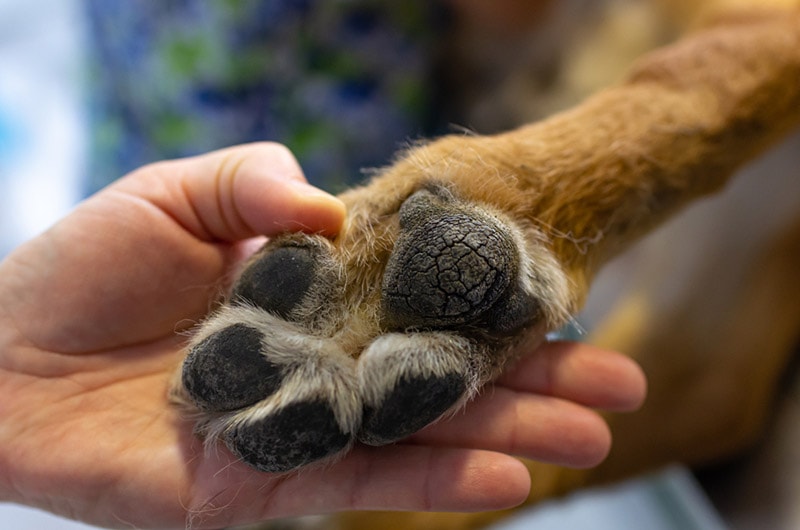
Dogs’ foot pads are important because they provide traction and act as shock absorbers. They are designed to withstand normal wear and tear caused by everyday activities, but they can become dry and cracked from the following:
- Exercise in rugged terrain
- Exposure to extremely hot or cold surfaces
- Contact with road salt, chemical de-icers, and residue from household cleaning products
You can help protect your dog’s paws by having them wear boots outside or applying a protective wax/balm before heading outdoors. It is a good idea to rinse or wipe their feet with warm water after they come inside, especially in the winter.
If you notice that your pup’s foot pads look dry or cracked, clean them regularly with warm water and monitor for signs of infection. Apply a pet-safe moisturizing wax or balm as needed and use boots to protect your dog’s feet when they are outside.
If the pads do not seem to be improving with this extra care, consult your veterinarian. In some cases, there may be an underlying medical condition that needs to be addressed.
4. Abrasions, lacerations, and puncture wounds
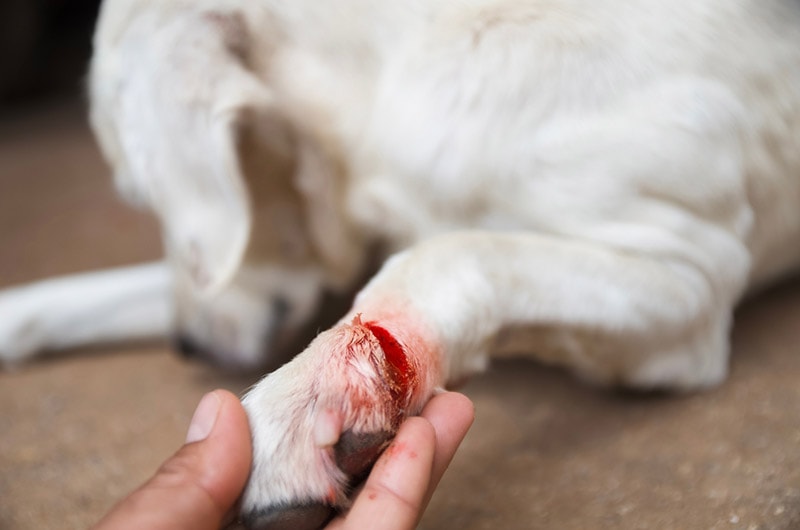
Just like people, dogs can get scrapes and cuts when they are out and about enjoying life. These types of wounds may result from walking on hot pavement, running on rough surfaces, or stepping on something sharp. Injuries like this generally cause discomfort, so you will likely notice your pup favoring the affected paw(s).
It is a good idea to seek veterinary attention. Wounds should always be cleaned thoroughly and it is important to make sure nothing is stuck in the paw. Your pup may need a bandage or stitches, depending on the severity of the injury. Antibiotics are often indicated and your pup will probably appreciate some pain medication! Be sure to follow all of your veterinarian’s directions closely.
5. Musculoskeletal injuries
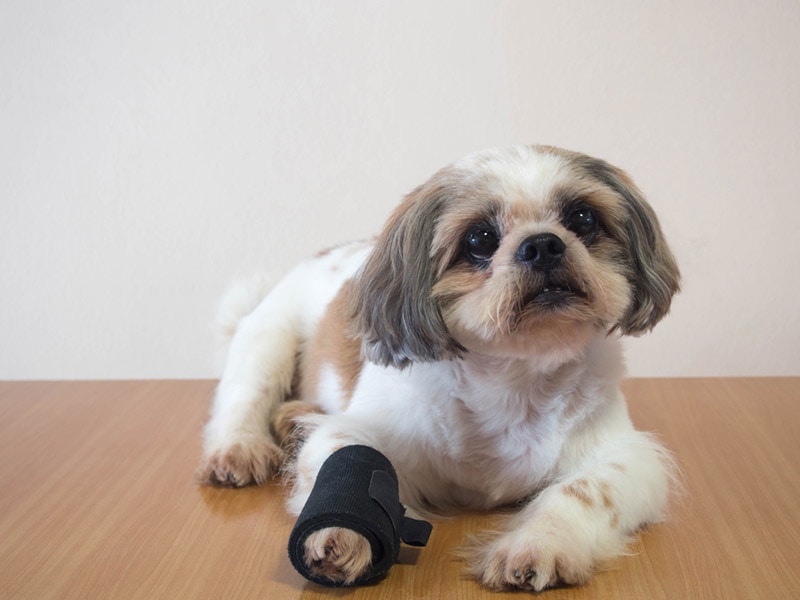
The word musculoskeletal refers to something affecting your dog’s muscles, tendons, ligaments, or bones. These types of injuries are often the result of accidents, such as:
- Getting caught in something (e.g., fence, door, wildlife trap)
- Jumping or falling from an unsafe height
- Being stepped on, crushed by something heavy, or hit by a car
Injuries of this nature usually cause fairly obvious pain and swelling.
If your dog has a swollen foot and/or is limping, it is wise to seek veterinary attention sooner than later. The veterinarian may suggest taking some radiographs (x-rays) to look at your pup’s bones. If they discover a fracture (broken bone), your dog may need a splint, cast, or even surgery.
Anti-inflammatory and pain medications are likely to be prescribed to keep your pup comfortable, and you will be advised to reduce their activity while the injury heals. For high-energy dogs, a mild sedative can help encourage rest (and protect your sanity if you have a pup who isn’t used to being confined to the house!).
6. Insect bites/stings

Bees, wasps, hornets, biting ants, and spiders can all give a nasty bite/sting if accidentally stepped on. If this happens to your pup, you may notice that they suddenly start limping or chewing at the affected paw.
Just like us, dogs can develop anaphylactic reactions. These are emergencies! Signs of a serious reaction typically appear within 20 minutes, but it is a good idea to monitor your dog for a few hours after the incident.
If there are no signs of anaphylaxis, here are some things you can do to help your pup:
- Apply a soothing paste to the bite/sting (e.g., baking soda mixed with water) to provide itch relief
- Cold therapy (up to 10 minutes at a time) with an ice pack, bag of frozen vegetables, or even a wet towel to reduce swelling
- Use a cone, if needed, to prevent your dog from licking/chewing at the affected area
- Ask your veterinarian if it is safe to give an antihistamine medication (be sure to confirm the exact brand and dose); they may also recommend applying a topical cream or ointment
As the site of the bite/sting heals, it is important to monitor the area for signs of infection and seek veterinary attention if you have any concerns.
7. Allergies

Veterinary dermatologists typically often describe allergy symptoms as showing up in “ears, feet, and rears”. If your pup frequently chews at his or her paws, this could be a sign of an adverse reaction to something in their food, environment, or both.
It is important to identify and treat allergies because they can cause significant discomfort! They often also lead to secondary infections when the skin is damaged by excessive licking, chewing, and scratching.
If you suspect that your dog may have allergies, schedule a consultation with your veterinarian. They will help you determine the next step(s), which may include:
- A strict diet trial to determine whether your pup is reacting to something in their food (there are currently no reliable blood or skin tests to diagnose adverse food reactions in dogs)
- Referral to a veterinary dermatologist for intradermal skin testing (IDT), which can identify reactions to environmental allergens
Adverse food reactions are managed by avoiding the offending foods. In many cases, veterinarians recommend feeding a prescription limited-ingredient or hydrolyzed diet. Many over-the-counter pet foods have been shown to contain ingredients that are not listed on their labels, likely due to cross-contamination during production.
Avoidance of environmental allergens is often not possible. Fortunately, many different treatment options are available, which are described in detail here.
8. Pododermatitis

The term “pododermatitis” simply refers to inflammation of the skin between the toes. This is usually the result of an infection with bacteria, yeast (or both) but can also be “sterile” (meaning no infectious agent is identified).
Dogs who experience frequent bouts of pododermatitis often have an underlying condition, such as allergies.
It is important for your veterinarian to know exactly what they are treating, so they will start by performing cytology. This involves swabbing your dog’s feet and examining the cells under a microscope. Depending on what they find, they may follow up with culture and sensitivity testing. This identifies the exact bacteria involved and determines which antibiotics are most likely to be effective.
Treatment may include:
- Topical therapy (e.g., medicated shampoos, sprays, and creams/ointments)
- Oral medication (e.g., antibiotics/antifungals, anti-inflammatories, anti-itch)
- Preventing self-trauma (e.g., cone to stop licking/chewing)
- Addressing any underlying issues (e.g., allergies)
Low-level LASER therapy has also been shown to be helpful in managing these cases.
9. Interdigital cysts (furuncles)
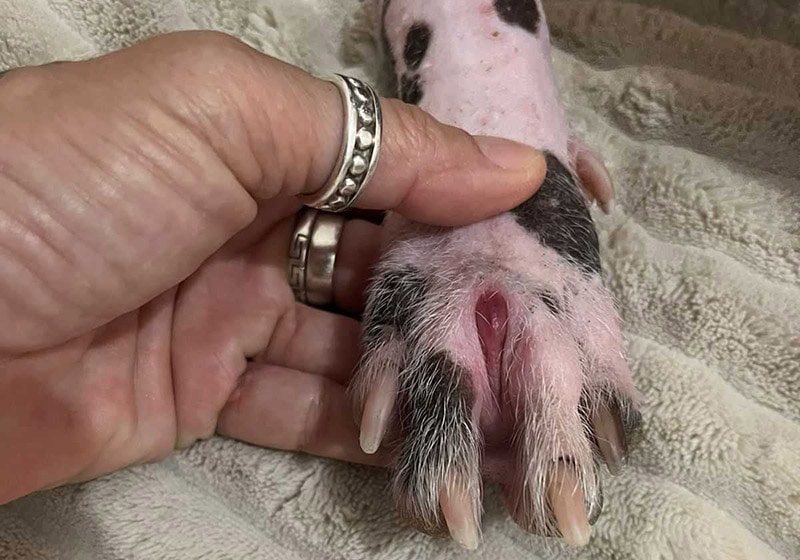
Interdigital cysts (more correctly called furuncles) are firm lumps that can develop between dogs’ toes as a result of hairs being forced deep into the skin. The body mounts an inflammatory response to keratin, and infection often follows.
Breeds with short, bristly hair (for example, English Bulldogs) seem to be at higher risk. Allergies and demodectic mange can be contributing factors. This condition is painful and affected dogs will often limp.
Treatment of interdigital cysts (furuncles) often requires a multi-pronged approach and can take a long time, so it is best to seek the help of a veterinarian.
Treatment is similar to that for pododermatitis:
- Topical therapy (e.g., medicated shampoos, sprays, and creams/ointments)
- Oral antibiotics (chosen based on the results of culture and sensitivity testing, usually for a minimum of 4 weeks)
- Prevent self-trauma (e.g., cone to stop licking/chewing)
- Manage underlying conditions
In some cases, surgical removal of the lesion(s) may be indicated.
A recent study demonstrated that low-level LASER therapy promotes healing and is also helpful for this condition.
Conclusion
Now that we have discussed some of the common problems that can affect dogs’ paws, here are some tips for keeping your pup’s feet in good condition:
- Trim their nails regularly to prevent ingrown nails, reduce the risk of torn/broken nails and other injuries.
- Avoid walking your dog on hot surfaces (e.g., pavement, sand).
- Consider boots to protect your dog’s paws from harsh terrain and extreme temperatures.
- In winter, use pet-safe ice melt products and rinse or wipe your dog’s paws with warm water after spending time outdoors.
- Practice handling your dog’s paws so you can check them frequently for signs of trouble.
If you have any concerns about your dog’s paws, please schedule an appointment with your veterinarian.
See also:
- What Does Digitigrade Mean? Vet Reviewed Explanation
- Why Are My Dog & Paws Red? 8 Common Causes & Treatments
Featured Image Credit: Kittima05, Shutterstock




